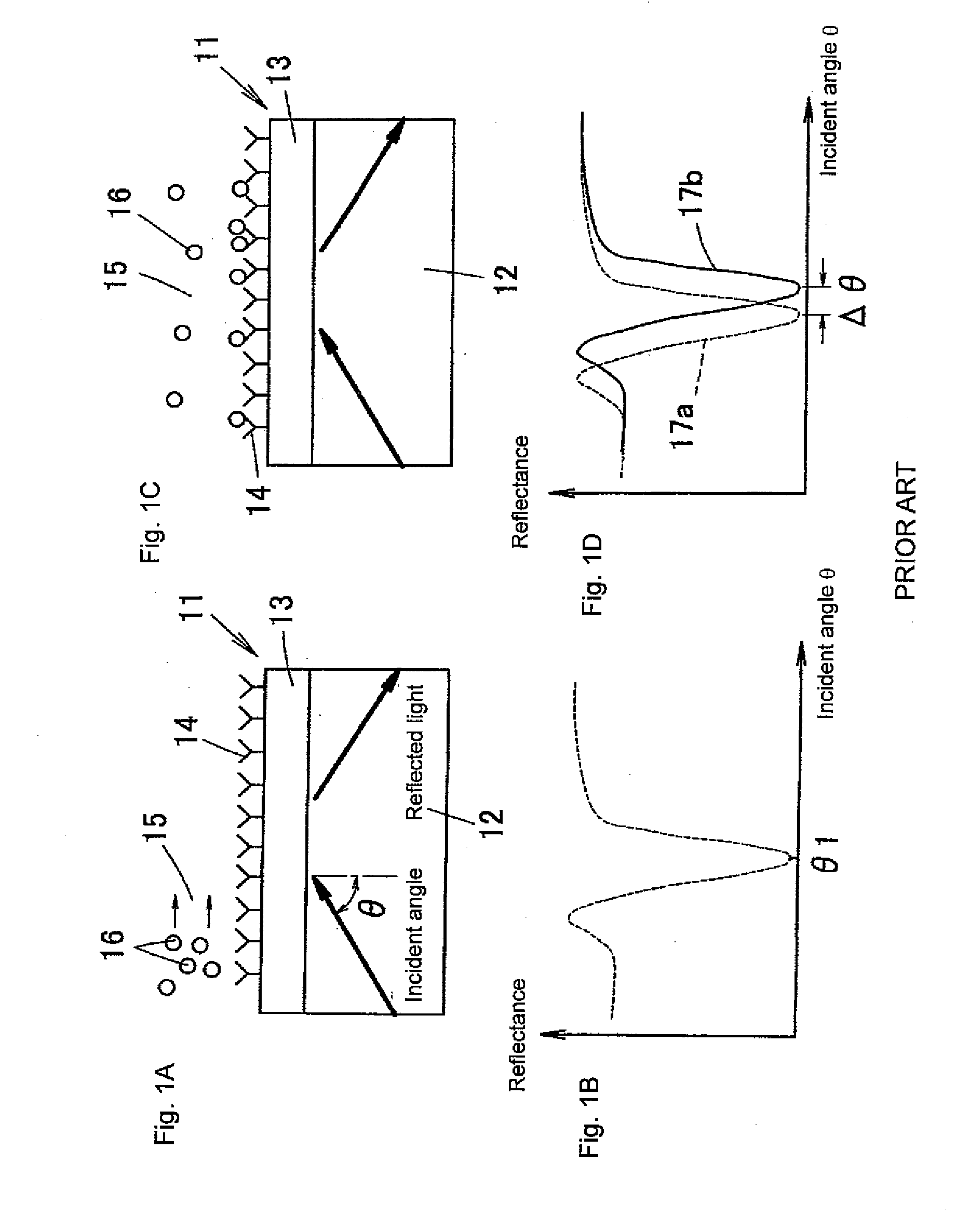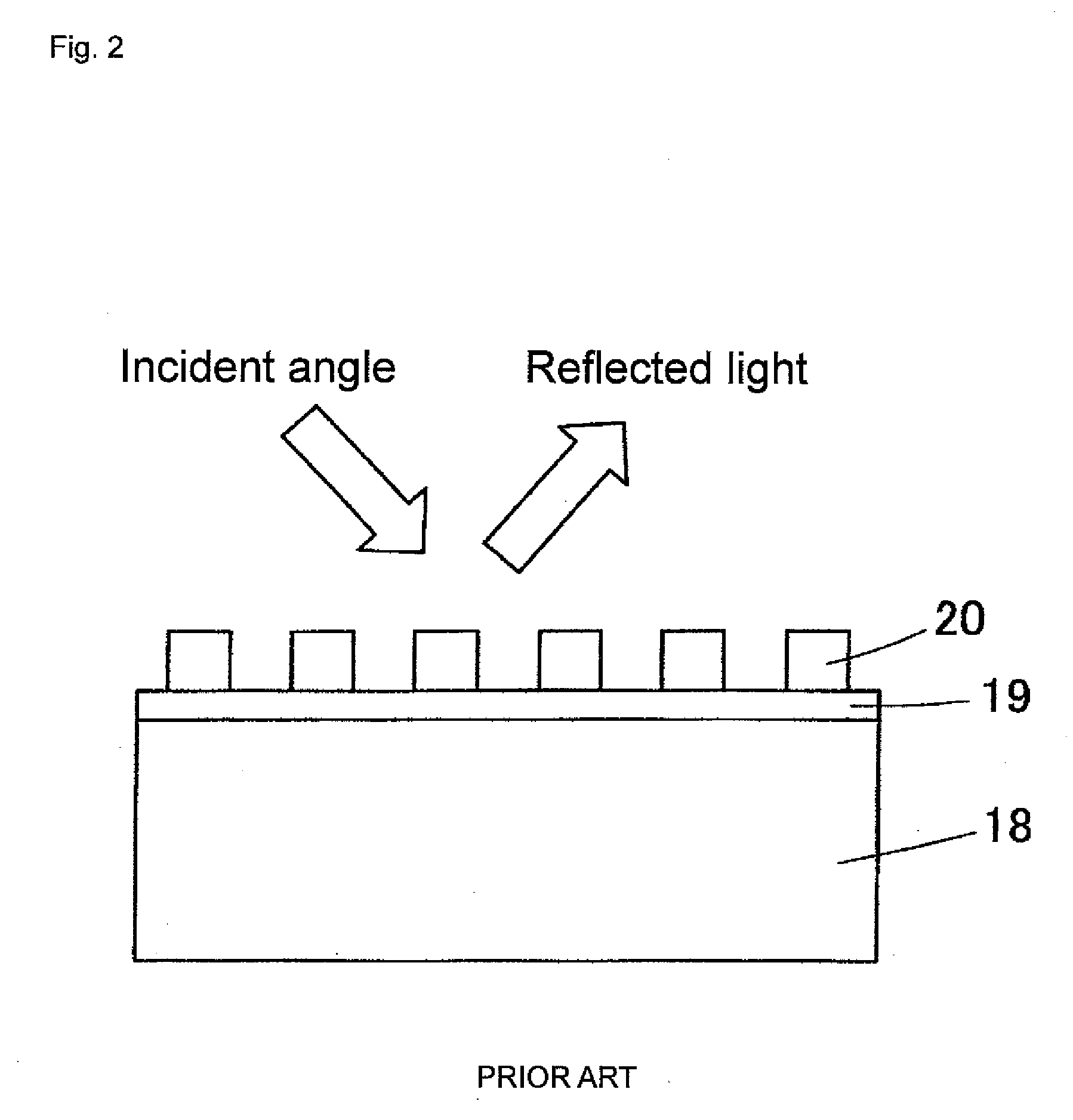Surface plasmon resonance sensor and sensor chip
a surface plasmon resonance and sensor chip technology, applied in the direction of color/spectral property measurement, instruments, material analysis, etc., can solve the problems of large device size, high device cost, and difficult manufacturing of small s/n ratio and high sensitivity sensors
- Summary
- Abstract
- Description
- Claims
- Application Information
AI Technical Summary
Problems solved by technology
Method used
Image
Examples
first embodiment
[0097]FIG. 9 shows a schematic view of a basic configuration of a local surface plasmon resonance sensor (hereinafter referred to as local SPR sensor) 31 according to a first embodiment of the present invention. The local SPR sensor 31 is configured by a light source 32 such as halogen lamp, an optical fiber 33, a collimator lens 34, a collimator plate 35 with pin holes, a polarization plate 36, a beam splitter 37 (or half mirror), an objective lens 38, a flow cell 48, a spectroscope 40, a photodetector 41, a data processing device 42, and a syringe pump 43.
[0098]The light source 32 is desirably that which irradiates a white light such as a halogen lamp, but may be of any type as long as it has light of a wavelength region used for measurement. Light L exit from the light source 32 is guided to the collimator lens 34 by the optical fiber 33. The collimator lens 34 collimates the light L exit from the distal end of the optical fiber 33, and passes the light as parallel beam. The ligh...
second embodiment
[0166]The sensor chip 39 according to a second embodiment of the present invention will be described. The sensor chip 39 of the second embodiment has a feature in that the central part of the bottom surface of the concave part 57 is raised towards the opening side.
[0167]Looking at the electric field distribution generated inside the concave part 57 shown in FIG. 17 in detail, it can be seen that the electric field intensity is not as strong in the vicinity of the bottom part of the concave part 57. This is because the electric force line in the concave part 57 is raised to the opening side. Thus, when the bottom surface of the concave part 57 is a flat plane as in the first embodiment, even if a specific substance such as protein bonds to the bottom surface of the concave part 57 as shown in FIG. 32A, such specific substance is positioned in a region of small electric field intensity, and thus change in index of refraction by the specific substance does not greatly contribute to sig...
third embodiment
[0178]The concave structure of the sensor chip according to the second embodiment of the present invention will now be described. In the sensor chip of the third embodiment, the concave part 57 is divided into plurals in the longitudinal direction, as shown in FIG. 40, as opposed to the concave part 57 extending in a groove form from end to end of the measurement region 44 as in the first embodiment. Consequently, the concave part 57 has a substantially rectangular concave structure, and is lined along two directions orthogonal to each other.
[0179]The manner of arraying the concave part 57 may be rectangular array (manner of arraying in a grid form) or delta array (manner of arraying in a staggering manner as in FIG. 40B), and the case of delta array will be described herein. The concave part 57 is lined at a constant pitch P similar to the first embodiment in a direction parallel to the polarizing surface of the incident light, but the width S1 of the concave part 57 and width S2 o...
PUM
| Property | Measurement | Unit |
|---|---|---|
| width | aaaaa | aaaaa |
| thickness | aaaaa | aaaaa |
| inclination angle | aaaaa | aaaaa |
Abstract
Description
Claims
Application Information
 Login to View More
Login to View More - R&D
- Intellectual Property
- Life Sciences
- Materials
- Tech Scout
- Unparalleled Data Quality
- Higher Quality Content
- 60% Fewer Hallucinations
Browse by: Latest US Patents, China's latest patents, Technical Efficacy Thesaurus, Application Domain, Technology Topic, Popular Technical Reports.
© 2025 PatSnap. All rights reserved.Legal|Privacy policy|Modern Slavery Act Transparency Statement|Sitemap|About US| Contact US: help@patsnap.com



